Folding bikes are widely used on the commute to work. They handle wonderfully on the paved city streets and are compact enough to take onto public transport. But what about those who want to be more adventurous?
Is A Foldable Bike Good For Off-Road?
Most folding bikes can take on a gravel road or towpath but need help getting through rougher terrain. The smaller wheels and lack of suspension systems offer limited resistance against the harsh bumps. However, folding mountain bikes are built explicitly for off-road conditions.
In this guide, I’ll tell you everything you need to know to start off-roading in a folding bike, including finding the best folding mountain bike, getting the right gear, which riding techniques to use, and finding a route that suits your bike.
Choosing the Best Folding Bike for Off-Roading
Though there is a wide variety, most folding bikes aren’t suitable for off-road use. Here are some characteristics to prioritize when searching for something that can go over rough terrain:
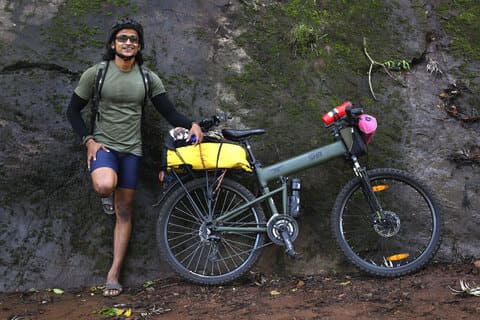
- Suspension system. This will allow you to cope better with uneven terrain. If you want to ride on tracks with larger obstacles, like rocks and tree roots, you will need suspension on both the front and rear of the bike. You only need a front suspension to ride less rugged tracks.
- Large wheels. Most folding bikes have smaller wheels, around 20 inches. This allows them to be folded into a compact package. For off-road riding, you should choose wheels between 26 and 27.5 inches. This will reduce rolling resistance, improve bump absorption, and give you more control.
- Strong frame. This ensures it can cope with the impact forces from bumps in the trail. In rare cases, the jump from the top of an obstacle has been enough to break the frame.
- Powerful brakes. You will need to be in control when riding over rugged off-road terrain. I always choose disc brakes for riding off-road unless I am on a tight budget.
- Wide gear selection. It’s common to see mountain folding bikes with 24 gears. This ensures that riders can navigate all types of terrains and inclines.
- Weight limits. Exceeding these limits places too much pressure on the frame and will cause breakages. Most of the time, though, this isn’t a problem. A high-quality folding mountain bike should be able to carry between 250 to 300 pounds.
- Size. The downside of folding mountain bikes is that they are larger than conventional folding bikes. But you should still be able to fit them into the boot of your car. The website will tell you the dimensions of the bike when folded.
Can You Ride a Brompton Off-Road?
It’s not advisable to take a Brompton off-road. These bikes have 16-inch wheels, which don’t provide any suspension, so you will feel every bump in the track. Due to the smaller wheels, you will need help to clear obstacles like rocks or tree roots.
The frame of a Brompton will also struggle to absorb the impact forces of a severe bump. This can lead to cracks, particularly around the hinge mechanism. While Brompton bikes have a polyurethane suspension system, it is designed for road use and will struggle to provide a smooth ride off-road.
Essential Gear for Off-Roading on a Folding Bike
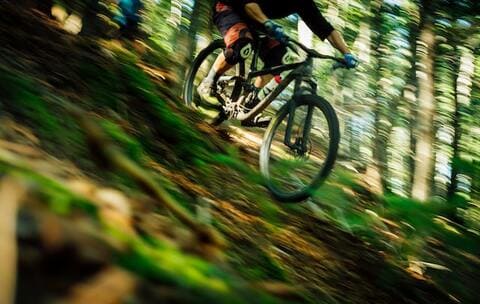
There are a few pieces of gear that you should take if you want to have a safe and comfortable off-road adventure on your folding bike:
- Safety gear. It’s vital to have a correctly fitted helmet. Use cycling sunglasses to keep rocks and dust out of your eyes, depending on the trail. Also, use gloves to help you deal with bumps along the track and maintain a firm grip on the handlebars.
- Puncture kit. This should contain everything you need to repair a flat tire. This can be stored in a saddle bag.
- Padded bike shorts. These can help you stay comfortable and prevent you from chafing.
- Water bottle. You’ll need to take a water bottle and food on longer rides. This allows you to replenish your energy levels.
- Fenders. This will prevent the wheels from throwing mud onto your clothing (note: this doesn’t bother me, having grown up in rainy Scotland!).
- Rear racks. If you plan on going on a longer ride, installing rear racks is a good idea. This allows you to include a pannier bag for your luggage.
This is just the essential list. The equipment required can be customized to better suit your needs. For example, take a first-aid kit if you are trying a challenging trail. Or if you are in an unfamiliar area, you should take a map.
Off-Roading Techniques and Safety Considerations
A decent folding mountain bike should be able to take on most trails. But if you want to have a smooth ride, you will need to work on your technique. For example, keeping your body loose as you go over the bumps is a good idea. This will help you deal with the impact forces as you allow the bike more space to move freely.
You will also need to think about where you are placing your weight.
For example, you must move back in the saddle during a downhill section, putting your center of gravity over the rear wheel. This will ensure you avoid getting flung over the handlebars during a rough section. On the other hand, it will often be easier to climb up a steep incline if you place your weight over the front of the bike.

The next thing to consider is the speed at which you are traveling.
You must maintain your momentum to help you get through challenging terrain. This is especially important when you are going uphill. This is why choosing a folding mountain bike with a wide gear selection is essential, so you can tailor your approach to suit the terrain.
Unlike conventional folding bikes, folding mountain bike brakes are very sensitive.
So you won’t need to apply much pressure to slow the bike down. This ensures that you will have plenty of control. Generally, it’s best to use the rear brake, especially when you need to slow down before a turn.
The rear brake will allow you to skid the bike, while a sudden deceleration from the front brake risks you being thrown over the handlebars.
When riding, focus your gaze on the trail in front of you. Keep focused on the path rather than staring at an obstacle. You’ll need to get used to using your peripheral vision to spot potential issues.
You also need to consider your jumping technique.
You must maintain eye contact with the location you want the bike to land. Try to land both wheels simultaneously and keep your body loose to better absorb the impact forces.
The most important thing, though, is to practice. At first, you will have accidents and may even fall off your bike. But you will grow more confident on the bike as you develop your off-roading skills.
Tips For Safe Off-Road Riding
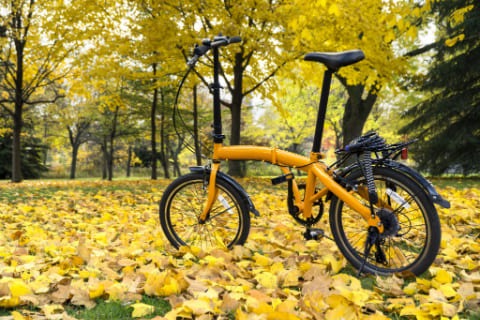
Here are my favorite tips to help you stay safe when you are riding off-road:
- Maintain your bike properly. Cleaning the mud off your bike and lubricating the chain will ensure the bike functions smoothly. You should have the knowledge and tools to create basic repairs, like fixing a flat tire and checking all bolts are correctly torqued.
- Wear appropriate safety gear. As we mentioned earlier, there are some critical pieces of safety equipment that you will need to carry with you. For example, you will need to ensure you are wearing a helmet.
- Tell friends and family members about your ride. It would be best to always tell people where you are riding and when you will return. Give them a call at the end of your ride. This ensures people know where to look for you if something goes wrong. Or you can ride as part of a group.
- Check the conditions of the trail before you leave. If you are riding in a natural park, you should be able to check the website and ensure the track is open. In this area, it’s vital to use your common sense. For example, riding after a week of storms, you can expect mud and fallen trees.
- Go slowly. It’s usually best to go slow and steady when riding off-road, especially when approaching a blind corner. Trying to rush can cause mistakes.
- Give other riders some space. You don’t want to get too close to the other riders on the track, as you might not be able to brake in time if there is an unpassable obstacle up ahead.
- Only ride on trails that allow mountain bikes. Sometimes tracks are designated for hikers only, and mountain biking is prohibited. Avoiding such routes is essential as the chances of colliding with a hiker are high, as they will be surprised (and often angry!) to see bikes on the trail.
Finding Off-Road Routes for Your Folding Bike

There are plenty of off-road trails for you to choose from. To make it easier to select the right one for you, they are often split into color-coded categories:
- Green. These are the easiest category. While there might be obstacles, they are avoidable. Any obstacles are relatively small and easy to navigate.
- Blue. These tracks are designed for intermediate users. The obstacles can’t be avoided. But they are less than eight feet high.
- Black diamond. These are tricky. There are unavoidable obstacles, which are under 15 feet high. There might also be variable terrain and bridges.
- Two black diamonds. This is the most challenging category. These trails are the narrowest, with most unavoidable obstacles under 15 feet.
Your local area might also have a terrain park. This isn’t a trail but a series of human-made obstacles. This is a chance to practice your skills before taking on the natural obstacles on the track.
Here are the things I typically consider when choosing an off-road route:
- Difficulty. It’s recommended that you start on tracks marked with green circles. These will allow you to get used to your folding mountain bike and riding off-road. As your confidence grows, you can move on to more advanced tracks.
- Length. The length of the track will determine whether you need to bring a water bottle and food.
- Condition. If riding in a National Park, the trail should be well-marked with plenty of signs to follow. But they can still be impacted by adverse weather. It’s best to check with the website to ensure it’s open before you set off.
The best option is getting into local parks and riding the tracks. You’ll often find that more experienced riders are happy to advise you on trails to check out.
Resources To Find Off-Road Routes
There are plenty of great resources that will help you find a tremendous off-road route; these include:
- US National Parks Website. You can search for national parks in your state and learn about the available off-road tracks. You’ll also be able to find information like how long the route is and how rugged the terrain is and download maps of the park.
- Body Positioning When Riding Off-Road. This video tells you how you should be sitting on your mountain bike.
- Cleaning and Degreasing Your Bike. It’s vital to keep your bike in good condition. This includes regular cleaning. This is especially important when traveling along muddy off-road tracks.
- Informal trail centers. Sometimes, local volunteers will work with private landowners to create a series of informal trails. You might need to ask around to find and gain access to these trails.
Can Folding Bikes Go On Trails? Final Verdict
Most folding bikes aren’t built to take on off-road trails. But there are plenty of suitable folding mountain bikes.
Armed with one, you can explore a range of exciting off-road locations. Since they handle similarly to conventional mountain bikes, your skill level is the only limit on where you can ride.

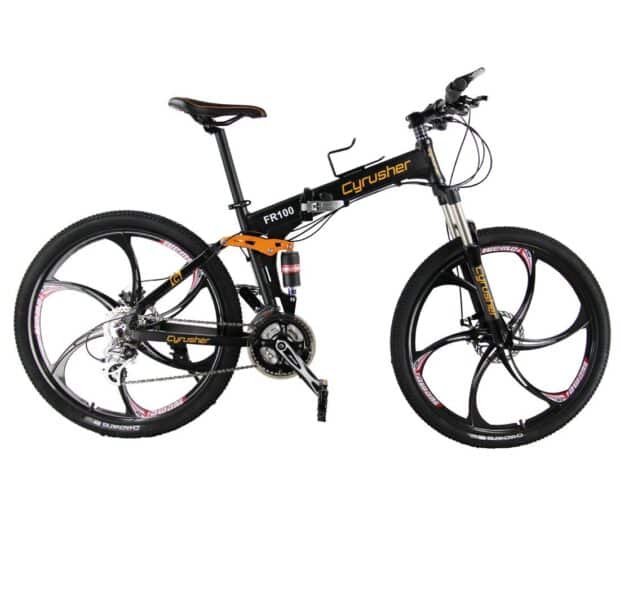
![Stowabike MTB Folding Bike Review [year]: Great Value For Money](https://www.foldingbikeguy.com/wp-content/uploads/2016/03/Stowabike-MTB-V2-Review-768x507.jpg)
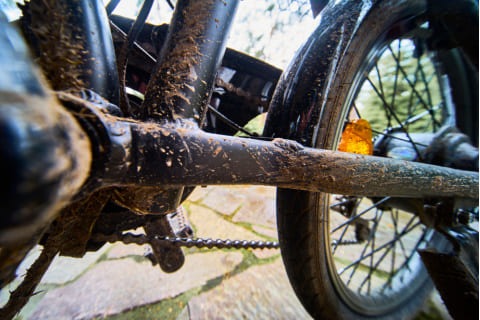
![7 Best Folding Mountain Bikes [Year]: Reviewed & Tested by Experts](https://www.foldingbikeguy.com/wp-content/uploads/Best-Folding-Mountain-Bike-1-768x512.jpg)
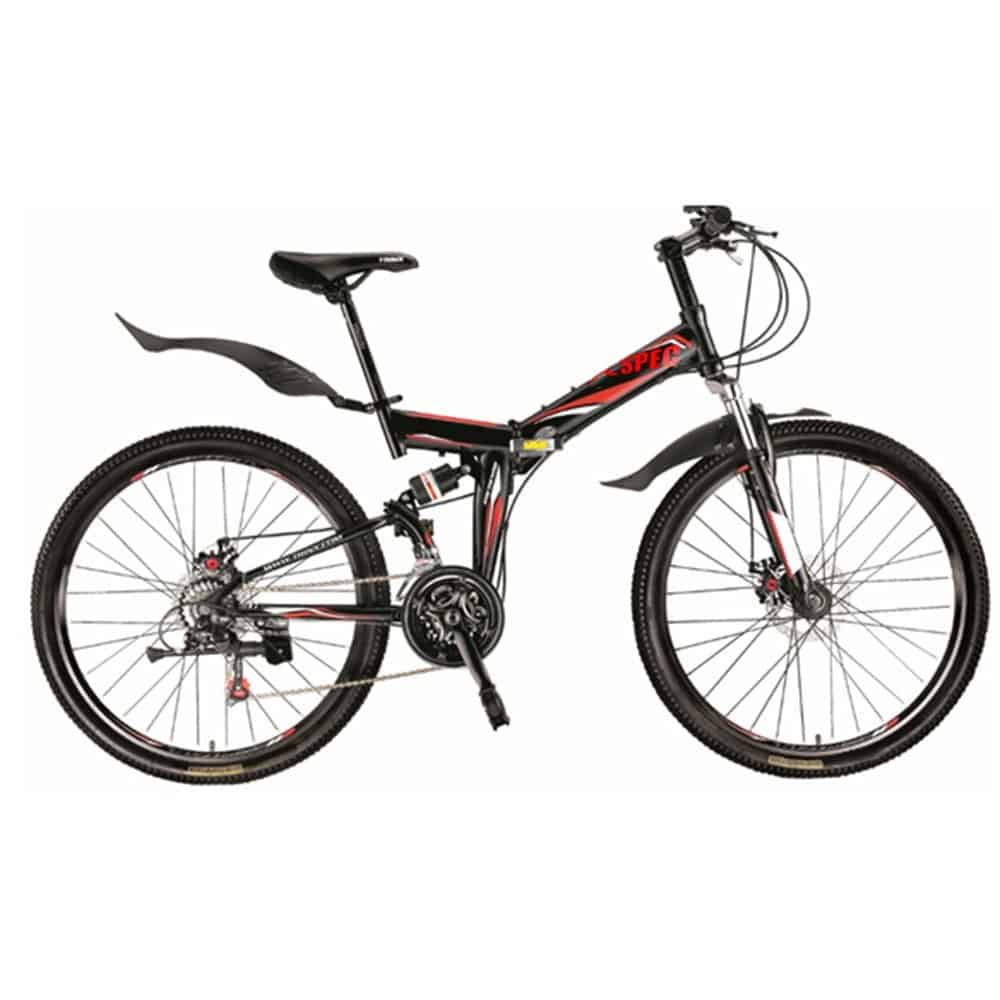
![GTM FT200 Folding Mountain Bike Review [year]](https://www.foldingbikeguy.com/wp-content/uploads/GTM-FT200-Folding-Mountain-Bike-Review.jpg)